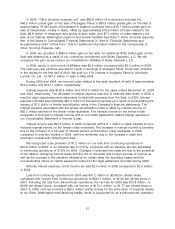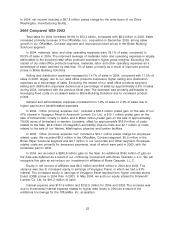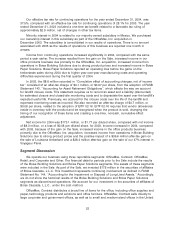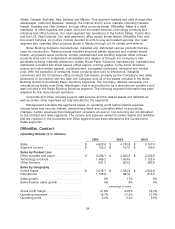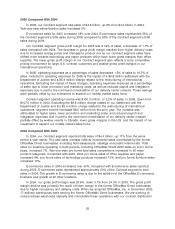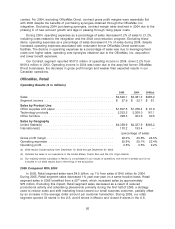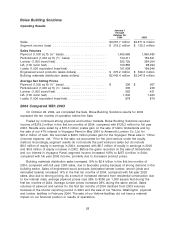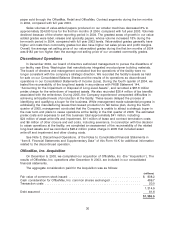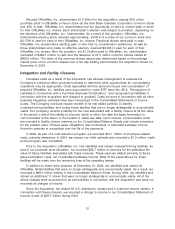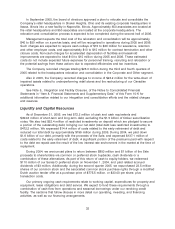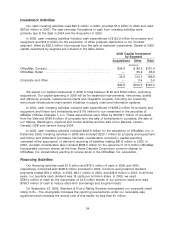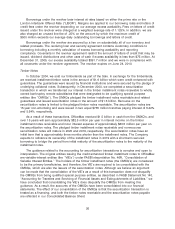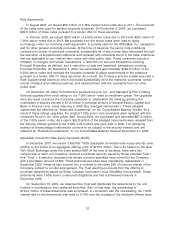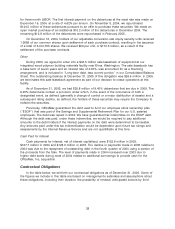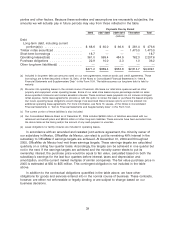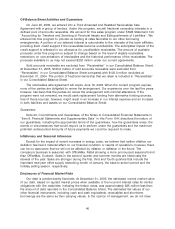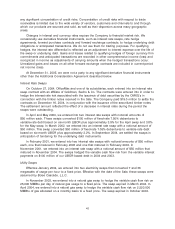OfficeMax 2005 Annual Report Download - page 35
Download and view the complete annual report
Please find page 35 of the 2005 OfficeMax annual report below. You can navigate through the pages in the report by either clicking on the pages listed below, or by using the keyword search tool below to find specific information within the annual report.We paid OfficeMax, Inc., shareholders $1.3 billion for the acquisition, paying 60% of the
purchase price in OfficeMax common stock (at the time Boise Cascade Corporation common stock)
and 40% in cash. OfficeMax, Inc. shareholders had the opportunity to elect to receive cash or stock
for their OfficeMax, Inc. shares. Each shareholder’s election was subject to proration, depending on
the elections of all OfficeMax, Inc., shareholders. As a result of this proration, OfficeMax, Inc.,
shareholders electing stock received approximately .230419 of a share of our common stock and
$3.1746 in cash for each of their OfficeMax, Inc. shares. Fractional shares were paid in cash.
OfficeMax, Inc. shareholders electing cash or who had no consideration preference, as well as
those shareholders who made no effective election, received $9.333 in cash for each of their
OfficeMax, Inc. shares. After the proration, the $1.3 billion paid to OfficeMax, Inc. shareholders
consisted of $486.7 million in cash and the issuance of 27.3 million common shares valued at
$808.2 million. The value of the common shares issued was determined based on the average
market price of our common shares over a ten-day trading period before the acquisition closed on
December 9, 2003.
Integration and Facility Closures
Increased scale as a result of the Acquisition has allowed management to evaluate the
Company’s combined office products business to determine what opportunities for consolidating
operations may be appropriate. Costs associated with the planned closure and consolidation of
acquired OfficeMax, Inc. facilities were accounted for under EITF Issue No. 95-3, ‘‘Recognition of
Liabilities in Connection with a Purchase Business Combination,’’ and recognized as liabilities in
connection with the acquisition and charged to goodwill. Costs incurred in connection with all other
business integration activities have been recognized in the Consolidated Statements of Income
(Loss). The Company conducts regular reviews of its real estate portfolio to identify
underperforming facilities, and closes those facilities that are no longer strategically or economically
viable. The Company records a liability for the cost associated with a facility closure at its fair value
in the period in which the liability is incurred, which is either the date the lease termination is
communicated to the lessor or the location’s cease-use date. Upon closure, unrecoverable costs
are included in facility closure reserves on the Consolidated Balance Sheets and include provisions
for the present value of future lease obligations, less contractual or estimated sublease income.
Accretion expense is recognized over the life of the payments.
In 2003, as part of a cost reduction program, we recorded $10.1 million of employee-related
costs, primarily severance. In 2004, we revised our initial estimate and recorded a $1.2 million credit
as the program was completed.
Prior to the Acquisition, OfficeMax, Inc. had identified and closed underperforming facilities. As
part of our purchase price allocation, we recorded $58.7 million of reserves for the estimated fair
value of future liabilities associated with these closures. These reserves related primarily to future
lease termination costs, net of estimated sublease income. Most of the expenditures for these
facilities will be made over the remaining lives of the operating leases.
In addition to these store closures, at December 31, 2003, we identified and closed 45
OfficeMax, Retail facilities that were no longer strategically and economically viable. As a result, we
recorded a $69.4 million liability in the Consolidated Balance Sheet. During 2004, we identified and
closed an additional 11 stores that were no longer strategically or economically viable. All of the
above charges were accounted for as exit activities in connection with the Acquisition and were not
recorded as charges to income.
Since the Acquisition, we closed 18 U.S. distribution centers and 2 customer service centers. In
connection with these closures, we recorded a charge to income in our Consolidated Statement of
Income (Loss) of $29.7 million during 2004.
31


